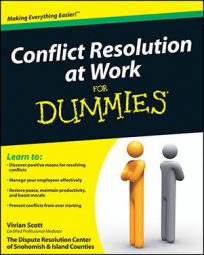Every employee meeting starts with an invitation, and conflict mediation is no different. You have some decisions to make regarding the way in which you’ll notify your employees about the meeting — and the option you choose depends on your relationship to the parties involved.
This step of your strategic process can vary, depending on the kind of workplace you’re in and the policies surrounding dispute resolution. Regardless of how you opt to let the parties know it’s time to talk, the goal of the invitation is to
Share information about the process
Allow the parties to voice any initial concerns
Prepare them to share their perspective at the meeting
The timing of this invitation may be as important as the invitation itself. Whether you choose to inform your employees that you’re requesting their attendance in person or in writing, do so in a manner that allows them enough time to process their thoughts, but not so much time that they dwell on it. And unless you feel like doling out cruel and unusual punishments, don’t set the meeting for a Monday and send the invitation on a Friday afternoon — your employees’ entire weekend will likely be ruined worrying about the meeting.
Issuing personal invitations
Your employees may not yet see a mediated conversation as a helpful and constructive thing, and that usually means resistance. If you choose to approach them in person, do so in a private and confidential way. Find a time when each employee is alone and has a few moments to chat with you. They’ll both likely have a number of questions, so allow some time for them to process the request and come back to you if they feel the need.
Expect, however, that if you offer a verbal invite to your meeting, you may begin to hear more than you’re ready for right away. Knowing that a mediated conversation is imminent, employees may try to deflect or defer the meeting. They may even try to convince you that the other one is clearly the problem.
A personal invitation is not the best bet if you’re not comfortable relaying all the details about your role, their roles, the goal of the meeting, the process you’ll be employing, what will be different about this meeting, and what will happen with any agreements. In that case, use the written option.
Sending written invitations
You know your workplace, and you know what’s appropriate and not appropriate when it comes to written meeting requests. If possible, make this invitation informal rather than formal. An e-mail or personal note is better than written instructions on company letterhead using very businesslike language. The best-written invitations are simple, personal, and confidential.
Provide both employees with an opportunity to talk to you if they have any questions or concerns. You don’t want them going into your meeting with false impressions or preconceived ideas about your intentions and goals.
The benefit to putting the request in writing is that it provides your employees time to consider their reactions and thoughts before engaging anyone in discussion. Many employees find taking some time to gather their thoughts is a great boon to their ability to address the conflict with the right frame of mind.

